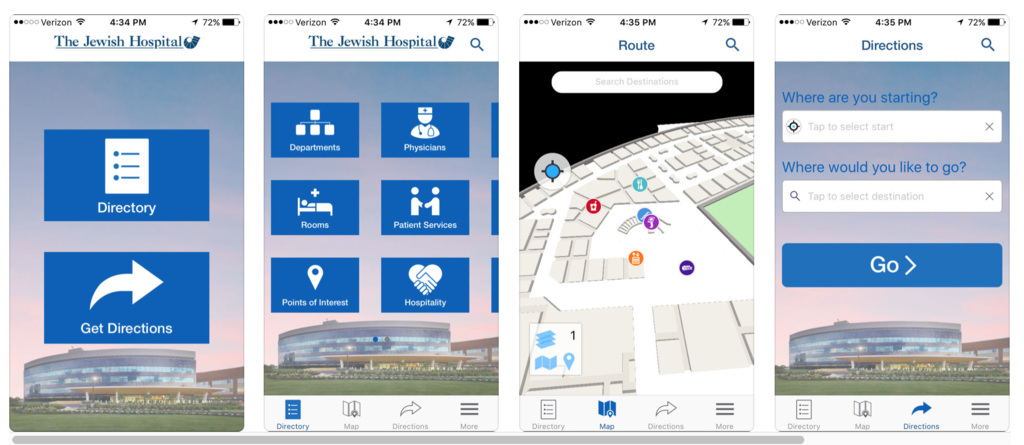You Are Here: Wayfinding App Improves Hospital Navigation
// By Althea Fung //
 In 2015, The Jewish Hospital — Mercy Health, a 184-bed acute-care facility in Cincinnati, was in the midst of a massive expansion project when a problem arose.
In 2015, The Jewish Hospital — Mercy Health, a 184-bed acute-care facility in Cincinnati, was in the midst of a massive expansion project when a problem arose.
“We were almost doubling the size of the hospital. During construction, we had to close our main entrance. So we had all of these altered routes of traffic. It was an ongoing challenge just to get someone from one side of the building to the other,” recalls Craig Schmidt, vice president and COO of The Jewish Hospital.

Craig Schmidt, vice president and COO, The Jewish Hospital — Mercy Health
To help shepherd patients and visitors from around the hospital, Schmidt hired ambassadors to escort people to their destination. But additional logistical issues made navigating the facility hard for visitors and staff.
Schmidt, who had heard about the burgeoning field of “indoor positioning systems” (IPS) used to pinpoint locations inside a building using sensory information, began looking into wayfinding systems that can help patients, visitors, and staff better navigate the facility during and after the construction project.
Getting lost in a hospital isn’t an uncommon experience. A report from 22Miles, a digital signage software company, found more than 30 percent of first-time visitors expressed confusion in finding locations within a hospital campus. The same report found 25 percent of staff members could not find some destinations within their own campuses. To combat this issue, more organizations are turning to wayfinding apps to navigate consumers from their home to the specific locations within the hospital.
The Jewish Hospital decided to contract with Connexient, a wayfinding and patient engagement company that offers mobile, web, and kiosk wayfinding services to health care organizations, to create “Right This Way,” its wayfinding solution. Using Connexient’s MediNav™ platform, Right This Way offers turn-by-turn indoor navigation through a smartphone app. Right This Way provides mapping for the hospital, physician practices, and parking facilities.

The Jewish Hospital’s wayfinding app, Right This Way, gives patients point-to-point directions to their destination.

Mark Green, co-founder and CEO, Connexient
“Signage is never going to go away in a hospital,” says Mark Green, co-founder and CEO of Connexient. “But we realized over time people are going to expect the experience they have outdoors when they go into large buildings because we’ve all experienced how confusing it can be to navigate a hospital.” Prior to founding Connexient, Green and his partner Joe Motta started GDS, a wayfinding signage company that provides digital displays for health care organizations.
Combining knowledge of health care and hospitals with IPS technology, Connexient is able to provide indoor positioning within two to four feet of accuracy. To get started, Connexient uses the hospital’s AutoCAD to determine the areas of the hospital to be mapped in the wayfinding system. Then beacons, small Bluetooth radio transmitters that Connexient calls “blue spots,” are placed throughout the facility.
Green says the process of mapping a facility and user testing can take several months, depending on the size and scope of the project. When the product launches, users get a navigation app that uses Bluetooth connectivity — not data or Wi-Fi — to usher patients throughout the hospital.
Integration with Google Maps; Plans for Epic
Additionally, the app includes Google Maps integration to direct patients from their home to the doctor’s office; a Parking Planner, which can guide users to the right parking location and then log the location of the user’s vehicle; and points of interest in the local community like hotels, dining, and nearby shopping centers. Green says Connexient is working on an Epic integration, so the app would be available directly through the EHR.
Though the blue-dot navigation allows the system to map the entire facility, Schmidt says it’s important to think critically about where the app can allow people to go.
“We spent the bulk of the time creating the maps, which may sound easy at first, but what’s complex is deciding as a facility, if someone is visiting their mom in room 325, do you want to take them to room 325, or do we want to take them to the front desk and then at the front desk have them directed to the room,” Schmidt says. He says you can restrict access to areas, but that would remove those places from the map, which may be used by employees. Maps specifically for internal employee use are available but would come at an additional cost.
Employees as App Ambassadors
Schmidt says for larger hospitals and systems, employee-specific maps may be useful, as they are a large portion of the user group. Green agrees, adding that employees can also serve as strong ambassadors for the app.
“We have [a client]; they use it for their patients and visitors. But they have over 40,000 employees that use our app not only because they get lost, but they also become familiar with the app, so if they see a visitor who looks lost, they can go up to the person and say, ‘Hey, we have an app. I’ll show you how to use it.’ So they become ambassadors for the app because they’re using it themselves,” Green says.
To roll out the app, Schmidt turned to a “super group” of tech-savvy employees in a variety of departments throughout the hospital. He additionally placed three wayfinding kiosks that patients and visitors can use to navigate throughout the hospital. Additionally, for those who do not want to download an app, a web version is available as a wayfinding “pre-planning” tool.
Increased Adoption Expected with Future EHR Integration
Schmidt says users have been slow to adopt the app, though he says future integration with the EHR could help improve usage: “If you can integrate the app into appointment reminders, every time I go to the doctor, it will keep the app fresh and relevant.” He says his current users do enjoy the app and are very engaged. He also notes that usage varies depending on the age of the user, with most of his known users — primarily employees — being younger and tending to be more tech-savvy.
Althea A. Fung is a digital content strategist and healthcare journalist. Reach her at fungus@altheafung.com.

